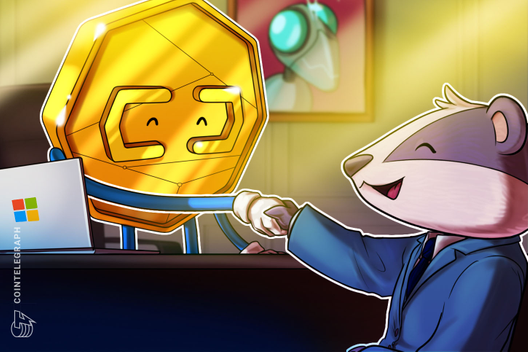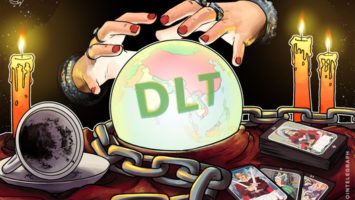Ever since the game CryptoKitties was released in November 2017, the concept of nonfungible token has been ingrained in the minds of developers and investors in the crypto community. However, 2019 has been the year that NFTs have gained mainstream attention. And it should come as no surprise that even huge, multinational companies are currently developing NFT projects.
Recently, Mirosoft’s blockchain-based cloud platform, Azure, released its own nonfungible tokens program called “Azure Heroes” with the aim of rewarding its developer community.
Azure Heroes
Through Azure Heroes, Microsoft is on a mission to empower technical practitioners of all backgrounds. With that as the objective, it has created a tool to inspire the community to learn, coach and build on Azure while promoting healthy and inclusive behavior.
Issuance and transactions of “Badger” collectibles will be carried out on the Ethereum network, allowing winners to hold them as NFTs. The tokens were created in partnership with Enjin, a platfor that specifically caters to the video game industry.
In order to earn one of these Badgers, Azure developers must first be nominated — either by themselves or by the community. Then, the community moderators will select the best nominees, based on their performance, to be awarded a Badger. Winners will then be provided with a QR code that can be used to redeem their Badgers via their Enjin wallet, where it can then be transferred to any other NFT-compatible Ethereum address.
The rise of NFTs
Fungibility refers to an item that is interchangeable with another, identical item. A dollar bill or a grain of rice is fungible — i.e., mutually interchangeable with other dollar bills or grains of rice. On the other hand, a house or a piece of art constitutes a nonfungible item — i.e., not mutually interchangeable with other houses or other works of art. Keeping this distinction in mind, an NFT is a unique digital asset with a traceable history that differentiates it from other assets that appear similar.
One of the most interesting things about NFTs is their ability to fundamentally change digital ownership. Until now, people never truly had ownership of anything that they purchased virtually. Purchasing in-game items and treating them as real-world assets is one thing, but the reality is that they don’t belong to the players who made the purchase; they belong to the game’s publishers.
However, 2019 was the tipping point for the adoption of NFTs, and there are a few reasons for this — at least in the gaming community. First of all, games like Gods Unchained were game changers upon their release.
Developed by Australia-based blockchain gaming startup Immutable, Gods Unchained is a turn-based digital trading card game that operates on the Ethereum blockchain. There are other collectible games — such as Decentraland, Etherbots, Spells of Genesis and Rare Pepe — whose popularity rose in 2019. However, outside of the gaming industry, companies utilizing NFTs, such as SuperRare, Zcrafty and Terra0, have also gained prominence.
Marketplaces like OpenSea, RareBits and OpenBazaar have also started to trade NFTs as crypto collectibles. The infrastructure around NFTs is also improving. 0xcert offers developer tools for issuing and managing NFTs. In addition, Codex Protocol has developed a decentralized registry for unique assets like art, fine wine, antiques and more.
Moreover, there are other factors for why NFTs are becoming more popular, one of them being an interest of multinational corporations in blockchain gaming. In September 2018, one of the biggest names in gaming, Ubisoft, sponsored the Blockchain Game Summit in Lyon, France. The following month saw Ubisoft become an inaugural member of Blockchain Game Alliance. When asked about the current use of NFTs in popular products and services, Ethan Pierse, the director at the CryptoAssets Institute, told Cointelegraph:
“Indiegogo and GoFundMe have also shown that people are willing to spend plenty of money supporting causes and products that they believe in. On Indiegogo, the product you get is called a Perk, and on Kickstarter, it is a reward, and people have contributed billions to those crowdfunded projects.”
Pierse went on to add that brand loyalty and self-identification are likely to intensify further, as supporters are also able to show off digital collectibles, concluding that:
“If those tokenized collectibles also have value as an asset to encourage hodling and trading, then we are looking at a digital version of the same craziness seen with Beanie Babies or Magic: The Gathering cards. A $90000 Magic card was just tokenized for 124 investors on collectible assets platform Mythic Markets.”
Diversification of use cases of NFTs
There is a noticeable drive for the development of NFT use cases beyond entertainment. Specifically with the case multi-layer blockchains, the foundational layer — which is the home of assets such as Bitcoin — is increasingly shifting toward being a store of value, presenting a segment of the market in which high-value NFTs can develop.
NFTs can signify ownership of high-value or sensitive physical, illiquid assets such as artwork or real estate. The latter is especially an area that can profit from the use of NFTs. Additionally, there is a drive to use tokenization and fractional ownership to make these investments liquid. For instance, NFTs can represent individual units in a property owned by multiple families.
Even though many look at NFTs as a way of building new financial assets and democratizing access to capital, regulation is likely to act as a hindrance. For example, the NFT platform Codex Protocol aspires to use NFTs as a medium to fractionalize ownership of a piece of art. While this is interesting in theory, there is a risk that doing so would turn these tokenized assets into securities, which would then need to be regulated as such.
Jonathan Brandt, the principal information technology consultant at the Willow Group who designed a course on blockchain at Minnesota State University, told Cointelegraph:
“I believe a major obstacle to the adoption of NFTs for more serious purposes, say, the provenance of antiquities or the tracking of a medical supply chain, is the lack of intuitive or obvious methods for redress and recovery. Ironically, many of the centralized institutions which blockchain stands to dismantle are really good at this. Microsoft, like it or not, has achieved tremendous mass-adoption of Internet Explorer, Windows, and the Office suite. It has the reach and the gravitas to nurture acceptance of NFTs.”
How NFTs can create value for an enterprise
Essentially, the evolution of NFTs is heavily dependent on the underlying blockchain infrastructure. Optimizing for scalability and transaction speeds, for example, is anticipated to have a huge impact on the rate of development for the space. Besides this, the absence of accessibility when it comes to NFTs is a real problem that has yet to be solved, and the entry of big players like Microsoft can go a long way to help.
Enterprises can use NFTs for inventory management, where certain tokens can be combined with other tokens to represent an assembled product with multiple component parts. Another area where NFTs can find application in enterprises such as Microsoft is in licensing software.
Such licenses have been traditionally represented by keys, but NFTs stored in wallets can now be used to grant permissions. Real estate is another example of a unique asset that can potentially be represented as NFTs. Additionally, identity management — both in social media and in enterprises — can leverage nontransferable NFTs.
Microsoft and blockchain
Through Azure, Microsoft has made many pioneering efforts toward blockchain adoption. Over the course of 2018, it has launched a blockchain development kit and the Azure Blockchain Workbench.
In May 2019, the company also unveiled the Azure Blockchain Services, which is a fully managed service that allows for the formation, management and governance of consortium blockchain networks.
Related: Crypto Firms Join Azure as Microsoft Fights Amazon for Market Share
Along with these products, the company has launched an extension to Visual Studio Code to help developers create and compile smart contracts based on Ethereum, and then deploy them on the public chain or on a consortium network in the Azure Blockchain Service. Regarding this, Pierse, the CryptoAssets Institute’s director, said:
“Azure is locked in a battle to differentiate itself with AWS, Oracle, and Heroku among others. If nothing else, this creates visibility and further engages Azure’s existing communities. I’m not sure that CTOs that have committed to other development platforms are going to make strategic decisions based on which ‘badger’ they can get, but I do think this could further showcase the engagement of Azure’s developer community.”
Soon after the announcement of Azure Heroes, Microsoft also unveiled new tokenization and blockchain data management services, highlighting the increased adoption of blockchain in enterprises.




Comments (No)